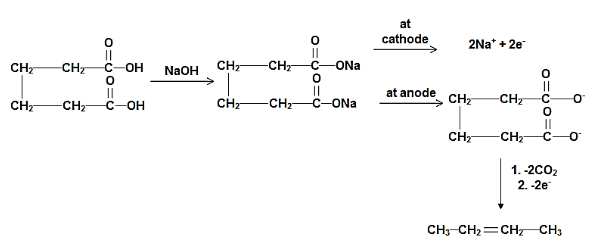
Answer
403.8k+ views
Hint: The Kolbe Electrolysis is the electrochemical oxidative decarboxylation of carboxylic acids leasing to the formation of the radicals that dimerise resulting in the formation of an alkene molecule.
Complete step-by-step answer:When a solution of 2, 3-dimethyl maleic acid is hydrolysed then it leads to the formation of but-2-ene. The carboxylate anion releases two electrons and it results in the formation of the carboxylic radical and then two molecules of carbon dioxide then it forms but-2-ene. There are certain side-products that are formed along with the products in the reaction. The reaction mechanism can be represented as follows:

Hence, the correct answer is option A.
Note: The Kolbe reaction is named after Hermann Kolbe. The Kolbe reaction is formally a decarboxylative dimerization of two carboxylate anions or acids.
The carboxylic acids can be formed from the alkenes by the oxidation using different oxidising agents such as osmium tetroxide and potassium permanganate and potassium dichromate. Ozonolysis is yet another route for the preparation of acids from alkenes.
The reaction of carbon dioxide with Grignard’s reagent also gives rise to carboxylic acids.
In the haloform reaction with iodine, bromine, and chlorine, methyl ketones are converted to the corresponding haloalkanes and the carboxylic acids.
Complete step-by-step answer:When a solution of 2, 3-dimethyl maleic acid is hydrolysed then it leads to the formation of but-2-ene. The carboxylate anion releases two electrons and it results in the formation of the carboxylic radical and then two molecules of carbon dioxide then it forms but-2-ene. There are certain side-products that are formed along with the products in the reaction. The reaction mechanism can be represented as follows:

Hence, the correct answer is option A.
Note: The Kolbe reaction is named after Hermann Kolbe. The Kolbe reaction is formally a decarboxylative dimerization of two carboxylate anions or acids.
The carboxylic acids can be formed from the alkenes by the oxidation using different oxidising agents such as osmium tetroxide and potassium permanganate and potassium dichromate. Ozonolysis is yet another route for the preparation of acids from alkenes.
The reaction of carbon dioxide with Grignard’s reagent also gives rise to carboxylic acids.
In the haloform reaction with iodine, bromine, and chlorine, methyl ketones are converted to the corresponding haloalkanes and the carboxylic acids.
Recently Updated Pages
How many sigma and pi bonds are present in HCequiv class 11 chemistry CBSE

Mark and label the given geoinformation on the outline class 11 social science CBSE

When people say No pun intended what does that mea class 8 english CBSE

Name the states which share their boundary with Indias class 9 social science CBSE

Give an account of the Northern Plains of India class 9 social science CBSE

Change the following sentences into negative and interrogative class 10 english CBSE

Trending doubts
Which are the Top 10 Largest Countries of the World?

Fill the blanks with the suitable prepositions 1 The class 9 english CBSE

Difference between Prokaryotic cell and Eukaryotic class 11 biology CBSE

The Equation xxx + 2 is Satisfied when x is Equal to Class 10 Maths

Give 10 examples for herbs , shrubs , climbers , creepers

Difference Between Plant Cell and Animal Cell

How do you graph the function fx 4x class 9 maths CBSE

Change the following sentences into negative and interrogative class 10 english CBSE

What are the main constituents of Dettol class 10 chemistry CBSE



